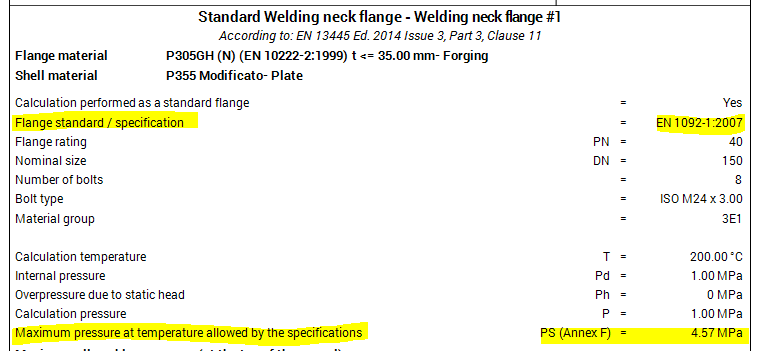Standard flanges and flanges according to calculation code
Using NextGen it is possible to design and calculate flanges; these components can be calculated in two different ways:
- Standard flange: this flange is usually bought compliant to a standard and suitable for a certain amount of pressure (rating). NextGen does not calculate this flange, it simply verifies that said rating is enough to withstand design pressure
- Flange according to a calculation code: this type of flange can be designed using a custom geometry (this usually happens for main body flanges) or using standard flange dimensions. NextGen calculates this flange according to calculation code in use
One thing to keep in mind is that each calculation code declares which flanges standard can be adopted using the first option when used within a project: this means that a flange can be considered standard only when used within a compatible calculation code. It is not possible for example to use ANSI flanges by their rating within an EN13445 project; similarly, an EN1092-1 or EN 1759-1 flange can't be used by its rating in an ASME project, even if EN 1759-1 flanges have basically the same dimensions as ANSI B16.
The following table shows how standard flanges are calculated when adopted in each calculation code supported by NextGen:

This applies to flanges selected from databases available in our software when "standard flange" option is checked:

Bolting validation is carried on only when explicitly required by the reference standard (e.g., bolts made of an "intermediate strength" material in ANSI B16.5).
Note: it is perfectly normal and very common to receive validation errors when calculating a standard flange according to a calculation code.
Calculation report of a standard flange is pretty simple; note the "maximum pressure allowed by specification" value.

Search the documentation
Customer area
Categories
- Getting started
- Frequently asked questions
- Customer support
- Installation
- License management
- Files management
- User interface
- Vessels design
- Heat Exchangers design
- Materials management
- Non-pressure loads
- Calculation report print
- Advanced design
- Versions and changelog archive
- Articles archive from sant-ambrogio.it website
Articles in this category
- How to create a reinforced ring opening (studding outlet flange)
- How to create a jacketed vessel
- How to use a National Annex in EN1991-1-4
- Forming Strains in ASME
- Set liquid level
- Limits on thickness for tubes and cylindrical shells in the VSR standard
- Thread calculation according to EN14359 Clause 5.5.6
- Cladding and weld overlay management
- How to design a stiffening ring against external pressure using NextGen
- Standard flanges and flanges according to calculation code
- How to design a gas cylinder with NextGen